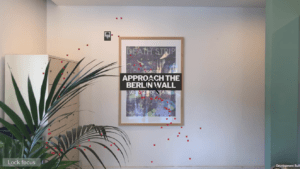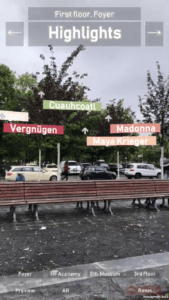 NYU engages with its urban communities not just in New York, but around the globe. In Berlin, this has recently involved working with museum spaces in collaboration with a government initiative thanks to the work of NYU Berlin Lecturer Pierre Depaz. Professor Depaz is an educator, artist and programmer from France. He’s taught at NYU and CUNY and is currently researching at the Film-Universität Babelsberg. He is interested in the multiple ways computers are attempting to represent and interface with human concepts and emotions. His academic research revolves around simulation, semantics and public organization through technological means, while his artistic practice includes digital games, computer simulations, interactive installations, networked performances and experimental web projects, and has been exhibited in NYC, Paris, Cairo, Abu Dhabi, Brussels and Berlin.
NYU engages with its urban communities not just in New York, but around the globe. In Berlin, this has recently involved working with museum spaces in collaboration with a government initiative thanks to the work of NYU Berlin Lecturer Pierre Depaz. Professor Depaz is an educator, artist and programmer from France. He’s taught at NYU and CUNY and is currently researching at the Film-Universität Babelsberg. He is interested in the multiple ways computers are attempting to represent and interface with human concepts and emotions. His academic research revolves around simulation, semantics and public organization through technological means, while his artistic practice includes digital games, computer simulations, interactive installations, networked performances and experimental web projects, and has been exhibited in NYC, Paris, Cairo, Abu Dhabi, Brussels and Berlin.Professor Depaz’s NYU Berlin course “Augmenting the Museum” is a class that is focused on designing and developing digital applications using Augmented Reality in the context of museum spaces. The class features a close collaboration with Museum4Punkt0, a German government research initiative. Throughout the semester, students have designed AR applications that are intended to complement the experience of artworks as well as the navigation of spaces by visitors of Berlin’s state museums (Humboldt Forum, Deutsches Historisches Museum and the Preußischer Kulturbesitz). This involved learning both technical development skills, conceptual designing skills as well as engaging with the teams of each of these museums to understand and address the needs and opportunities of each of these sites.
 Student projects have resulted in approaches as different as navigational applications within the new Humboldt Forum, digital games aimed at communicating the uniqueness of 19th century pop-up books are using augmented reality to offer walks across the city while overlaying historical buildings with photographs from the Berlin municipal archives. Based on students availability in the summer, some of the groups have followed-up with their respective museums and their ideas have been taken into account in the process of digital renovation of those museums.
Student projects have resulted in approaches as different as navigational applications within the new Humboldt Forum, digital games aimed at communicating the uniqueness of 19th century pop-up books are using augmented reality to offer walks across the city while overlaying historical buildings with photographs from the Berlin municipal archives. Based on students availability in the summer, some of the groups have followed-up with their respective museums and their ideas have been taken into account in the process of digital renovation of those museums.The photos depict two of the prototypes developed. The first in order to raise awareness about the Berlin Wall and the second to orient visitors based on which works they would like to see first. Since they are spatial applications, a still frame does not fully capture the offering but gives a sense.